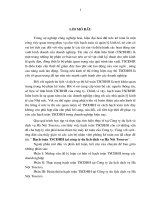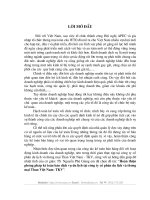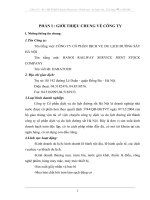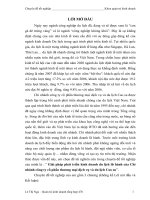PHIÊN DỊCH DU LỊCH (TOURISM INTERPRETING)
Bạn đang xem bản rút gọn của tài liệu. Xem và tải ngay bản đầy đủ của tài liệu tại đây (535.35 KB, 10 trang )
<span class="text_page_counter">Trang 1</span><div class="page_container" data-page="1">
BỘ GIÁO DỤC VÀ ĐÀO TẠO
<b>TRƯỜNG ĐẠI HỌC CẦN THƠ </b>
<b>CỘNG HÒA XÃ HỘI CHỦ NGHĨA VIỆT NAM Độc lập – Tự do – Hạnh Phúc </b>
<b>ĐỀ CƯƠNG CHI TIẾT HỌC PHẦN </b>
<b>1. Tên học phần: PHIÊN DỊCH DU LỊCH (TOURISM INTERPRETING) - Mã số học phần: FL243 </b>
<b>- Số tín chỉ học phần: 02 tín chỉ </b>
<b>- Số tiết học phần: 60 tiết thực hành, 60 tiết tự học - Chương trình đào tạo: Phiên dịch-Biên dịch tiếng Anh 2. Đơn vị phụ trách học phần: </b>
<b>- Bộ môn: Ngôn ngữ và Văn hóa Anh - Khoa: Khoa Ngoại ngữ </b>
<b>3. Điều kiện tiên quyết: XH465 </b>
<b>4. Mục tiêu của học phần: Học phần này sẽ … Mục </b>
<b>4.1 </b>
Trang bị cho người học kiến thức về phiên dịch trong lĩnh vực du lịch. Phiên dịch trong lĩnh vực du lịch là các hoạt động giáo dục nhằm nâng cao ý thức bảo vệ môi trường thiên nhiên cho du khách thông qua các hoạt động được tổ chức tại những nơi tham quan được bảo vệ như là sở thú, viện bảo tàng, công viên quốc gia, công viên chủ đề v.v... Qua đó giúp người học phát huy vai trò của người phiên dịch du lịch trong việc phối hợp với hướng dẫn viên trong việc giáo dục cho du khách và cộng đồng về bảo tồn môi trường thiên nhiên.
2.1.3a
<b>4.2 </b>
Rèn luyện kỹ năng phiên dịch du lịch cho người học thông qua việc rèn luyện kỹ năng nghe hiểu, kỹ năng ghi chú, và kỹ năng giải quyết vấn đề trong quá trình phiên dịch du lịch), nâng cao vốn từ vựng về danh lam thắng cảnh và các dịch vụ ở Việt Nam và trên thế giới, ứng dụng các nguyên tắc và kỹ thuật dịch đã được học trong học phần Lý thuyết dịch, nâng cao khả năng trình bày trước đám đơng bằng tiếng Anh và tiếng Việt, và nâng cao khả năng xử lý tình huống khi tham gia phiên dịch du lịch cho du khách trong các tình huống giả định.
CO1 <sup> Xác định được vai trò của phiên dịch du lịch trong việc phối </sup>
hợp với hướng dẫn viên du lịch trong việc giáo dục bảo vệ môi <sup>4.1 </sup> <sup>2.1.3a </sup>
</div><span class="text_page_counter">Trang 2</span><div class="page_container" data-page="2"><b>CĐR </b>
<b>tiêu </b>
<b>CĐR CTĐT Kiến thức </b>
trường thiên nhiên cho du khách và cộng đồng địa phương thông qua hoạt động phiên dịch khi người hướng dẫn viên kể chuyện (hơn là chỉ kể thông tin) về hiện vật, phong cảnh, văn hóa, lịch sử, mơi trường của một địa điểm tham quan.
CO2
Trình bày lưu lốt nội dung về danh lam thắng cảnh và dịch vụ của một số địa điểm nổi tiếng ở địa phương và các vùng khác trong nước và nước ngoài nhằm giúp du khách hiểu được văn hóa, lịch sử của điểm tham quan và cung cấp thông tin chính xác cho du khách về các dịch vụ du lịch (dịch vụ nhà hàng, khách sạn, giao thông, vé máy bay, quà lưu niệm, giá cả, dịch vụ homestay, các hoạt động vui chơi giải trí, tham quan…)
4.2 2.1.3a
CO3
Áp dụng được nguyên tắc dịch thuật theo nghĩa (meaning-based translation) để phiên dịch du lịch, mạnh dạn uyển chuyển thay đổi câu từ, cấu trúc ngữ pháp của bản gốc sao cho bài phiên dịch được diễn đạt tự nhiên, dễ hiểu trong ngôn ngữ mục tiêu, nghĩa là sử dụng được ngôn ngữ tự nhiên phù hợp với từ vựng, ngữ pháp và văn hóa của ngơn ngữ mục tiêu.
4.2 2.2.1a
CO5
Phát triển các kỹ năng mềm cần thiết cho người phiên dịch du lịch (kỹ năng giao tiếp hiệu quả với du khách, đồng nghiệp; tìm tài liệu trên Internet; làm việc nhóm, nói trước cơng chúng, khả năng trình bày, khả năng làm việc với áp lực cao, và kỹ năng học tập suốt đời )
4.3 2.3a
CO7
Xác định được trách nhiệm nâng cao hiểu biết đúng đắn cho du khách về văn hóa, lịch sử, dịch vụ, chủ quyền, an ninh quốc gia và chính trị của đất nước, nhưng vẫn đảm bảo du khách và mọi người thưởng thức được những trãi nghiệm thú vị, tuyệt vời khi tham quan.
4.1 2.3c
<b>6. Mơ tả tóm tắt nội dung học phần: </b>
Phiên dịch du lịch cần sự tinh tế, nhạy bén, và khéo léo trong ứng xử của mỗi phiên dịch viên/hướng dẫn viên. Vì vậy, người phiên dịch trong lĩnh vực du lịch cần phải trang bị cho mình kiến thức về các lĩnh vực: văn hóa, lịch sử, du lịch, khách sạn, nhà hàng, dịch vụ, giao tiếp xuyên văn hóa…và cả sự năng nổ, nhiệt tình trong cơng việc để tạo cơ hội phát triển cho
<i>bản thân. Học phần Phiên dịch du lịch gồm 02 phần sẽ tạo cơ hội cho sinh viên được (1) thực </i>
hành nhiều về công việc của phiên dịch du lịch liên quan đến các điểm du lịch trong và ngoài nước, và (2) giúp sinh viên hiểu rõ ý nghĩa của phiên dịch trong lĩnh vực du lịch đó là gián tiếp nâng cao ý thức cho du khách và người dân địa phương về việc bảo tồn tài nguyên thiên nhiên và danh lam thắng cảnh của một quốc gia, khu vực.
<b>7. Cấu trúc nội dung học phần: 7.1. Lý thuyết </b>
</div><span class="text_page_counter">Trang 3</span><div class="page_container" data-page="3"><b>Nội dung Số tiết </b>
<b>CĐR HP Phần 1. VAI TRÒ CỦA PHIÊN DỊCH TRONG LĨNH VỰC DU </b>
<b>LỊCH TẠI CÁC KHU BẢO TỒN THIÊN NHIÊN (ZOOS, MUSEUMS, NATIONAL PARKS, THEME PARKS, PROTECTED AREAS) </b>
2.1. Phiên dịch danh lam thắng cảnh, văn hóa, lịch sử, dịch vụ ở
<b>9. Nhiệm vụ của sinh viên: </b>
Sinh viên phải thực hiện các nhiệm vụ như sau: - Tham dự tối thiểu 80% số tiết học lý thuyết.
- Tham gia đầy đủ 100% giờ thực hành và có báo cáo kết quả.
- Thực hiện đầy đủ các bài tập nhóm/bài tập và được đánh giá kết quả thực hiện. - Tham dự kiểm tra giữa học kỳ.
</div><span class="text_page_counter">Trang 4</span><div class="page_container" data-page="4">3 Điểm kiểm tra giữa học kỳ
Phương pháp đánh giá: Thuyết trình
u cầu: Mỗi cặp sinh viên cùng đóng vai hướng dẫn viên và phiên dịch du lịch. Mỗi bài phiên dịch dài khoảng 03 phút. Nội dung do sinh viên tự chọn và được sự phê duyệt trước của giảng viên. Trình bày và tự ghi âm, quay hình. Nộp video clips lên hệ thống Elearning.
20% C02-CO7
4 Điểm thi kết thúc học phần
Hình thức đánh giá: Thuyết trình
Yêu cầu: Mỗi nhóm 05 sinh viên đóng vai (du khách, hướng dẫn viên du lịch và phiên dịch viên du lịch) cho một địa điểm du lịch tự chọn. Các thành viên thay phiên đóng tất cả các vai. Nội dung do sinh viên tự chọn và được sự phê duyệt trước của giảng viên. Trình bày trước lớp.
<b>11. Tài liệu học tập </b>
<b>Thông tin về tài liệu <sup>Số đăng ký </sup><sub>cá biệt </sub></b>
[1]. Gianna Moscardo, Barbara Woods and Rebecca Saltzer. (2004). Chapter 12 The Role Gianna Moscardo, Barbara Woods and Rebecca Saltzer. (2004). Chapter 12 The Role of Interpretation in Wildlife Tourism.
[2]. Ham, S. H. & Krumpe, E. E. (1996). Identifying audiences and messages for nonformal environmental education – a theoretical framework for
<i>interpreters. Journal of Interpretation, 1(1), 11–23. </i>
[3]. National Park Service U.S. Department of the Interior. (2007).
<i>Foundational Competencies for All NPS Interpreters. Interpretive </i>
Development Program.
[4]. Course package: Bao gồm các bài giới thiệu về văn hóa, lịch sử, danh lam thắng cảnh, dịch vụ của các địa danh nổi tiếng ở 03 miền đất nước và trên thế giới, được sưu tầm từ các tài liệu giảng dạy của ngành Hướng dẫn viên du lịch và các Youtube links về
<i>hướng dẫn viên du lịch. </i>
<b><small>12. Hướng dẫn sinh viên tự học: </small></b>
</div><span class="text_page_counter">Trang 5</span><div class="page_container" data-page="5"><b><small>Buổi Nội dung Số tiết Nhiệm vụ của sinh viên </small></b>
<small>lý thuyết </small>
<small>thực hành </small>
<b><small>1 Phần 1. VAI TRÒ, Ý NGHĨA CỦA PHIÊN DỊCH VIÊN DU LỊCH </small></b>
<small>1.1 The Role of Interpretation in Wildlife Tourism. </small>
<small>2 Đọc trước tài liệu [1] </small>
<b><small>2 </small></b> <small>1.2 Identifying Audiences and Messages for Nonformal Environmental Education </small>
<small>2 Đọc trước tài liệu [2] </small>
<b><small>3 </small></b> <small>1.3 Foundational Competencies for All National Park Interpreters </small>
<small>2 Đọc trước tài liệu [3] </small>
<b><small>4 </small></b> <small>1.4 Mẹo phiên dịch cho hướng dẫn viên – phiên dịch văn hóa, mơi trường, lịch sử và di sản: </small>
<small> </small>
<small>1.5 How to tell great stories on tour? Story telling advice for guides </small>
<small> </small>
<small>2 Đọc trước tài liệu [4] Cụ thể: Xem trước 02 video clips 1.4 và 1.5 </small>
<b><small>5-8 Phần 2. THỰC HÀNH PHIÊN DỊCH DU LỊCH </small></b>
<small>2.1. Phiên dịch danh lam thắng cảnh, văn hóa, lịch sử, dịch vụ ở ĐBSCL. </small>
<small>Optional: Field trip, phiên dịch du lịch tại các điểm tham quan ở Thành phố Cần Thơ, ví dụ: Chợ nổi, vườn trái cây Cái Sơn, Viện bảo tàng Cần Thơ, Đình Bình Thủy, Chùa Nam Nhã, </small>
<b><small>Nhà cổ Bình Thủy </small></b>
<small>8 Đọc trước tài liệu [4] </small>
<small>9-12 2.2. Phiên dịch danh lam thắng cảnh, văn hóa, lịch sử, dịch vụ ở TPHCM – Đà Lạt </small>
<small>8 Đọc trước tài liệu [4] 13-16 2.3. Phiên dịch danh lam thắng cảnh, văn hóa, </small>
<small>lịch sử, dịch vụ ở Hà Nội </small>
<small>8 Đọc trước tài liệu [4] </small>
<small>19-22 2.4. Phiên dịch danh lam thắng cảnh, văn hóa, </small>
<small>lịch sử, dịch vụ ở Đà Nẵng – Huế – Nha trang </small> <sup>8 </sup>
<small>Đọc trước tài liệu [4] 23-26 2.5. Phiên dịch danh lam thắng cảnh, văn hóa, </small>
<small>16 Thi cuối học kỳ </small>
</div><span class="text_page_counter">Trang 6</span><div class="page_container" data-page="6"><small>MINISTRY OF EDUCATION AND TRAINING </small>
<b>CAN THO UNIVERSITY </b>
<b>SOCIALIST REPUBLIC OF VIETNAM Independence-Freedom-Happiness </b>
-<b> COURSE LENGTH: </b> 8 lecture hours, 48 practice hours, 60 self-study hours
<b>2. COURSE MANAGEMENT UNITS : </b>
<b>- DEPARTMENT: </b> English Language and Culture
<b>4. COURSE OBJECTIVES: The course is aimed to help students to: </b>
<b>OUTCOMES </b>
<b>4.1 </b>
Describe the meaning of interpretation in toursim which is various educational activities organised at tourist sites such as zoos, national/theme parks, and museums with an aim to raise the awareness of tourists in preserving the natural enviroment and increase their roles as tourism interpreters in indirectly educating tourists to preserve the nature.
2.1.3a
<b>4.2 </b>
Give professional interpreting at a tourist site during the assignment, using improved listening skills, increased vocabulary command on tourist sites and services, translation principles and techniques learnt in the course Theory of Translation, improved public speaking skills in Vietnamese and English, and problem solving skills that are needed in real situations and simulations.
2.2.1a,b
<b>4.3 </b> <sup>Develop soft skills necessary for tourism interpreters </sup> <sup>2.2.2a,b </sup>
<i><b>5. COURSE STUDENT OUTCOMES: At the end of the course, students will be able to: </b></i>
<b>Outcomes Kiến thức </b>
CO1
Identify the role of a tourism interpreter who together with with the tour guide indirectly educate tourists and local people to conserve nature through such activities as strorytelling (rather than telling facts) when talking about the artifacts, landscapes, culture, history, environment of a
4.1 2.1.3a
</div><span class="text_page_counter">Trang 7</span><div class="page_container" data-page="7"><b>CO Description Objectives <sup>Program </sup>Outcomes Kiến thức </b>
tourist site.
CO2
Present the information of a tourist site fluently so that tourists can understand and admire the beauty of the culture and history of the place. Provide them with accurate information of services of restaurants, hoyels, transportation, booking offices, sourvenir shops, prices, homestay, recreation centers, sightseeing, etc.
4.2 2.1.3a
CO3
Apply meaning-based translation in interpreting tourist sites, using natural form of the target language that is appropriate in the grammar, vocaburary and culture of the target language.
4.2 2.1.3a
<b>Skills </b>
CO4 <sup>Interpret fluently speeches on tourist sites, having a quick </sup>
CO5
Develop soft skills necessary for tourism interpreting (năng giao tiếp hiệu quả với du khách, đồng nghiệp; tìm tài liệu trên Internet; làm việc nhóm, nói trước cơng chúng, khả năng trình bày, khả năng làm việc với áp lực cao, và kỹ năng học tập suốt đời )
4.3 2.3a
CO7
Develop a tourism interpreter’s sense of responsibility of enhancing tourists and local people’s understanding of culture, history, services, as well as politics and sovereignty of Vietnam and other countries, indirectly educating tourists and local people on natural conservation, and at the same time making sure that they have enjoyable expereriences with the tour sites.
4.1 2.3c
<b>6. Course description: </b>
Toursim interpreting requires interpreters as well as tour guide to be knowlegable and tactful. Therefore, tourism interpreters need to be eqipped with a wide range of knowldege of different fields: culture, history, hospitality services, and intercultural comminication so that they can have continuing professional development. They also need to be active and
enthusiastic in their work for personal growth. The course Tourism Interpreting is coposed two parts. The theoretical part will provide students with foundation knowledge of
interpretation in torusim and its educational roles in helping tourists preserve the natural world and tourist sites of countries and regions. The practical part will train students to have the ability to professionally interpret for popular tourist sites in Vietnam and in the world.
<b>7. COURSE STRUCTURE: </b>
<b>7.1. THEORETICAL KNOWLEDGE </b>
<b>STUDENT OUTCOMES </b>
</div><span class="text_page_counter">Trang 8</span><div class="page_container" data-page="8"><b>PART 1. THE ROLES OF INTERPRETATION IN TOURISM AT PROTECTED AREAS (ZOOS, MUSEUMS, NATIONAL PARKS, THEME PARKS, PROTECTED AREAS) </b>
<small>2.1 Practicing interpreting for tourist sites and services of the Mekong Delta, Vietnam </small>
Students are expected to:
- Attend at least 80% of the lecture hours
- Attend 100% practice hours and have a result report - Complete all the required assignments
- Attend mid-term and final exams - Be responsible for self-study hours.
<b>10. Evaluation: 10.1. Evaluation </b>
2 Participation Actively participate in class activities 15% CO6 3 Midterm exam Assessment method: Presentation
Requirement: Pairs of students will take turn roleplaying a tour guide and then an interpreter. The speech should be about three minutes long. Topics can be in the choice of the students, but need to be pre-approved by the instructor. Videotape the role play and submit the video clip on the Elearning system for grading
C02-CO7
4 End-of-semester exam
Assessment method: Presentation Requirement: Pairs of students will take turn role-playing a tour guide, some interested tourists, and then an interpreter.
C02-CO7
</div><span class="text_page_counter">Trang 9</span><div class="page_container" data-page="9">The interpreted speech should be about three minutes long. Topics can be in the choice of the students, but need to be pre-approved by the instructor. The groups will be presenting in front of the class for assessment
<b>11. Required reading materials </b>
<b>specification </b>
[1]. Gianna Moscardo, Barbara Woods and Rebecca Saltzer. (2004). Chapter 12 The Role Gianna Moscardo, Barbara Woods and Rebecca Saltzer. (2004). Chapter 12 The Role of Interpretation in Wildlife Tourism.
[2]. Ham, S. H. & Krumpe, E. E. (1996). Identifying audiences and messages for nonformal environmental education – a theoretical framework for
<i>interpreters. Journal of Interpretation, 1(1), 11–23. </i>
[3]. National Park Service U.S. Department of the Interior. (2007).
<i>Foundational Competencies for All NPS Interpreters. Interpretive </i>
<small>1.1 The Role of Interpretation in Wildlife Tourism. </small>
<small>2 Read Material [1] </small>
<b><small>2 </small></b> <small>1.2 Identifying Audiences and Messages for Nonformal Environmental Education </small>
</div><span class="text_page_counter">Trang 10</span><div class="page_container" data-page="10"><small> </small>
<b><small>5-8 Phần 2. PRACTICE OF TOURISM INTERPRETATION </small></b>
<small>2.1 Practicing interpreting for tourist sites and services of the Mekong Delta, Vietnam. </small>
<small>Optional: Field trips to tourist sites in Can Tho City: Chợ nổi, vườn trái cây Cái Sơn, Viện bảo tàng Cần Thơ, Đình Bình Thủy, Chùa Nam Nhã, Nhà cổ Bình </small>
<b><small>Thủy and practice of interpreting </small></b>
<small>8 Read Material [4] </small>
<small>9-12 2.3 Practicing interpreting for tourist sites and services of HCMC & Dalat </small>
<small>8 Read Material [4] 13-16 2.4 Practicing interpreting for tourist sitesand </small>
<small>services of Hanoi </small>
<small>8 Read Material [4] 17-18 Midterm exam 4 Read Material [4] 19-22 2.5 Practicing interpreting for tourist sites </small>
<small>and services of Danang, Hue, Nha Trang </small>
<small>8 Read Material [4] 23-26 2.6 Practicing interpreting for tourist sites </small>
<small>and services of Northwest regions </small>
<small>8 Read Material [4] 27-29 2.6. Practicing interpreting for foreign tourist </small>
<small>sites of students‘ choice. For example: </small>
<small>- Best Tour Guide Ever!!: </small>
<small> </small>
<small>- Virtual Tour Guiding English: Kalinga Province: </small>
<small> </small>
<small>- Qualities of a Sucessful Tour Director and Guide: </small>
<small> </small>
<small>6 Pairs or small groups of students are supposed to select a short travel video clip of their choice and practice interpreting. </small>
<small>30 COURSE REVISION & EXAM PREPARATION </small>
<small>2 16 FINAL EXAM </small>
</div>







